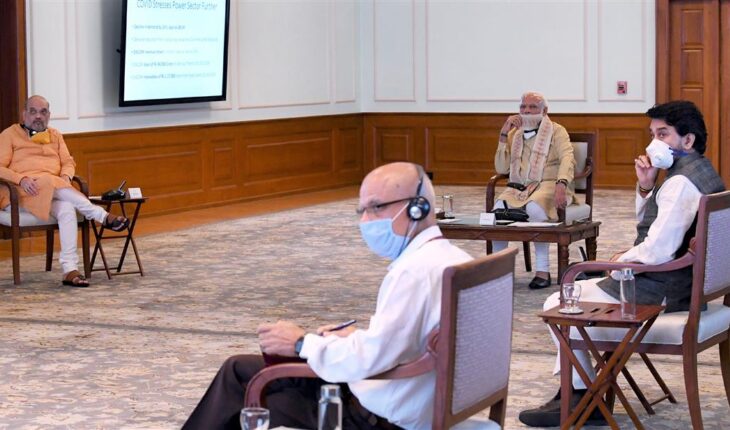New Delhi; After a comprehensive review, and in view of the Lockdown measures having led to significant gains in the COVID-19 situation in the country, Ministry of Home Affairs (MHA), Government of India (GoI) issued an Order under the Disaster Management Act, 2005, today, to further extend the Lockdown for a further period of 2 weeks with effect from May 4, 2020. MHA also issued new guidelines to regulate different activities in this period, based on the risk profiling of the districts of the country into Red (hotspot), Green and Orange Zones. The guidelines have permitted considerable relaxations in the districts falling in the Green and Orange Zones.
The criteria for identification of districts as Red, Green and Orange Zones have been spelt out in detail in the letter dated April 30, 2020, issued by Ministry of Health and Family Welfare (MoHFW), GoI. The Green Zones will be districts with either zero confirmed cases till date; or, no confirmed case in the last 21 days. The classification of districts as Red Zones will take into account the total number of active cases, doubling rate of confirmed cases, extent of testing and surveillance feedback from the districts. Those districts, which are neither defined as Red nor Green, shall be classified as Orange zones. The classification of districts into Red, Green and Orange Zones will be shared by MoHFW with the States and Union Territories (UTs) on a weekly basis, or earlier, as required. While States and UTs can include additional districts as Red and Orange Zones, they may not lower the classification of a district included by MoHFW in the list of Red or Orange Zones.
A number of districts of the country have, within their boundaries, one or more Municipal Corporations (MCs). It has been observed that due to higher population density within the MCs, and consequent greater inter-mixing of people, the incidence of COVID-19 within the boundary of the MC(s) is higher than in the rest of the district. In the new guidelines, therefore, it has been provided that such districts will be classified into two Zones, i.e., one Zone for the area under the boundary of the MC(s); and, another for the area falling outside the boundary of the MC(s). If the area outside the boundary of the MC(s) has reported no case for the last 21 days, it will be allowed to be classified as one stage lower than the overall classification of the district as either Red or Orange. Hence, this area will be classified as Orange, in case the district is overall Red; or as Green, in case the district is overall Orange. This classification will enable more economic and other activities in that area of the district, which is relatively less affected by the incidence of COVID-19, while also ensuring that due caution continues to be exercised so that these areas remain free from COVID-19 cases. This dispensation has been made only in respect of districts having Municipal Corporation (s).
In the Red Zones, outside the Containment Zones, certain activities are prohibited in addition to those prohibited throughout the country. These are: plying of cycle rickshaws and auto rickshaws; running of taxis and cab aggregators; intra-district and inter-district plying of buses; and, barber shops, spas and saloons.
Certain other activities have been allowed in the Red Zones with restrictions. Movement of individuals and vehicles is allowed only for permitted activities, with a maximum of 2 persons (besides the driver) in four-wheeler vehicles, and with no pillion rider in the case of two-wheelers. I
A large number of other activities are allowed in the Red Zones. All industrial and construction activities in rural areas, including MNREGA works, food-processing units and brick-kilns are permitted; besides, in rural areas, without distinction to the nature of goods, all shops, except in shopping malls are permitted. All agriculture activities, e.g., sowing, harvesting, procurement and marketing operations in the agricultural supply chain are permitted. Animal husbandry activities are fully permitted, including inland and marine fisheries. All plantation activities are allowed, including their processing and marketing. All health services (including AYUSH) are to remain functional, including transport of medical personnel and patients through air ambulances. A large part of the financial sector remains open, which includes banks, non-banking finance companies (NBFCs), insurance and capital market activities, and credit co-operative societies. Operation of homes for children, senior citizens, destitutes, women and widows etc.; and operation of Anganwadis has also been permitted. Public utilities, e.g., utilities in power, water, sanitation, waste management, telecommunications and internet will remain open, and courier and postal services will be allowed to operate.
Most of the commercial and private establishments have been allowed in the Red Zones. These include print and electronic media, IT and IT enabled services, data and call centres, cold storage and warehousing services, private security and facility management services, and services provided by self-employed persons, except for barbers etc., as mentioned earlier. Manufacturing units of essential goods, including drugs, pharmaceuticals, medical devices, their raw material and intermediates; production units, which require continuous process, and their supply chain; Jute industry with staggered shifts and social distancing; and manufacturing of IT hardware and manufacturing units of packaging material will continue to be permitted.
In the Orange Zones, in addition to activities permitted in Red Zone, taxis and cab aggregators will be permitted with 1 driver and 2 passengers only. Inter-district movement of individuals and vehicles will be allowed for permitted activities only. Four wheeler vehicles will have maximum two passengers besides the driver and pillion riding will be allowed on two-wheelers.
In the Green Zones, all activities are permitted except the limited number of activities which are prohibited throughout the country, irrespective of the Zone. However buses can operate with upto 50% seating capacity and bus depots can operate with upto 50% capacity.
All goods traffic is to be permitted. No State/ UT shall stop the movement of cargo for cross land-border trade under Treaties with neighbouring countries. No separate pass of any sort is needed for such movement, which is essential for maintaining the supply chain of goods and services across the country during the lockdown period.
No separate/ fresh permissions will be required from authorities for activities already permitted to operate under the guidelines on Lockdown measures up to May 3, 2020. The Standard Operating Protocols (SOPs) issued by MHA will continue to operate such as transit arrangement for foreign national(s) in India; release of quarantine persons; movement of stranded labour within States/ UTs; sign-on and sign-off of Indian seafarers, movement of stranded migrant workers, pilgrims, tourists, students and other persons by road and rail.
State/ UT Governments are mandated to strictly enforce the lockdown guidelines and they shall not dilute these guidelines issued under the Disaster Management Act, 2005, in any manner.




